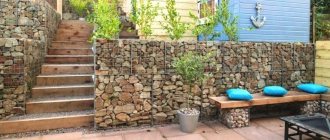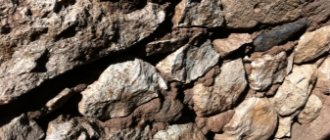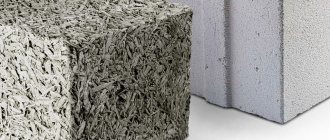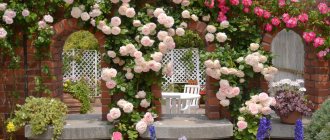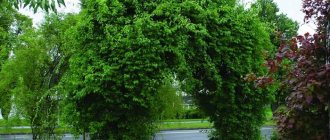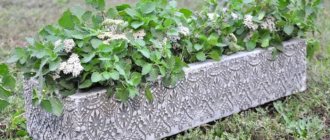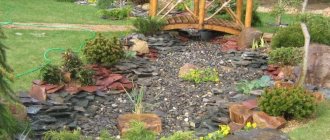Gardeners and professional landscape designers love evergreen thujas, because they will delight you 12 months a year with their greenery and lush crown. Thujas have an amazing ability to purify the air, filling the garden with a subtle resinous aroma. Arborvitae can be safely called coniferous plants, which occupy a leading position in the garden. The variety of crown shapes, heights, and colors of needles provide a wide range of applications in landscape design. Tall varieties form dense and dense hedges, spherical and topiary forms act as tapeworms on an emerald lawn, and dwarf varieties are comfortably located in rock gardens and rock gardens. Thuja occidentalis is the most common species; it has many varieties, from which you can create almost any design solution.
PYRAMIDAL AND CONICAL CROWN SHAPE
Pyramidal or conical arborvitae are often vigorous growers and therefore ideal for creating neat, dramatic living walls.
Such elegant fences protect the area from strong winds and hide your garden from the prying eyes of neighbors. In a landscape composition, they are planted in the background, allowing beautiful flowering shrubs to come forward. (thuja occidentalis Smaragd) - Tall tree with emerald green needles, dense, conical crown.
The color of the needles does not change throughout the year and does not fade with insufficient lighting. In the middle zone, this variety is extremely popular not only for its attractive appearance, but also for its unconditional resistance to unstable climatic conditions.
It grows slowly - only 15-25 cm in height per year and in adulthood will reach 6 meters. Used as a hedge, to decorate stylistic gardens and create delightful compositions.
(thuja occidentalis Brabant) is an evergreen coniferous plant characterized by its impressive size and rapid growth.
Can grow up to 8 meters in height. Thuja Brabant has a cylindrical crown, and its branches very often fall to the ground. The needles are bright green in color with delightful golden tips that shimmer favorably in the sun.
To be highly decorative, the tree needs pruning and crown shaping. Looks impressive as a living wall for zoning a site.
(Thuja occ. Aurea Nana) is a low-growing representative of conifers. It has an ovoid habit in youth, and over the years it acquires a conical shape. The shoots are yellowish, dense.
The needles are thick, scaly, green with a golden tint, and remain on the tree all year round. The advantage of this variety: the “correct” arrangement of branches, bright color and small compact size.
Very young plants require shelter for the winter with spruce branches; adults have fairly strong frost resistance. An ideal solution for small, rocky gardens and alpine slides.
(thuja occidentalis Wagneri) is a tree with an ovoid or conical-ovate crown, small in stature, up to 3.5 m tall.
The crown is dense, directed upward, of a light green hue, which in the sun becomes silvery-metallic. Thuja Wagneri prefers fertile soils and a sunny location. Overwinters without shelter while retaining decorative needles.
For planting, it is recommended to choose open areas with sufficient light, but protected from strong winds. Used for compositions, lawn decoration and ideal as a hedge.
(Thuja occidentalis Columna) is the best variety for hedges that will divide your site into zones or hide from prying eyes.
Thuja Columna grows up to approximately 6 meters in height. The shoots are horizontal, short, slightly curved towards the ends. The apex of the habit is obtuse. The needles are bright green in color, small and scale-like, with a characteristic shine.
The variety is valued for its fast growth and high resistance to bad weather. Tolerates mild drought and frost, is unpretentious to growing conditions and is easy to care for. Needs crown formation and spring pruning.
(Thuja occidentalis Malonyana) - is a columnar variety of thuja with extremely unusual twisting shoots.
Narrow, upright, fast-growing form. The color is deep, rich green. Dense needles.
Unlike other varieties, Thuja Maloniana is a tall, slender tree that grows up to 10 meters or more and has a crown diameter of up to 3 m.
Usage
The popularity of thuja is understandable: its variety and shape diversity allows it to be used in landscape compositions of any style. Having an attractive appearance, this breed is unpretentious, tolerates urban conditions well, is very frost-resistant, and lends itself well to haircuts. This set of positive qualities is enough to win everyone’s love and respect.
In 1566, his subjects from distant America brought the richest gifts to the French king: gold, clothing, Indian arts and crafts, the fruits of strange overseas plants and a slender coniferous tree with unusual scale-like leaves, spreading a pleasant aroma of resin. This exotic plant has taken root well in the climate of France. He tolerated the haircut perfectly, which made it possible to enrich the royal park with a variety of topiary figures. The French king appreciated the new plant and called it the tree of life , because its evergreen, fragrant needles enlivened the garden all year round.
This is how the thuja occidentalis acquired a second home in Europe. This magnificent slender tree, 12–20 m high, has a compact, low-hanging pyramidal crown.
| See also: |
BALL SHAPE.
These versatile trees pair well with other plants and a variety of decorative items. Due to their slow growth, compositions with thujas retain their original appearance for a long time, which is why they are often used in mixborders, rock gardens and Japanese gardens.
Dwarf varieties grow well in containers and pots; with their help you can create a kind of coniferous lawn. A medium-sized variety of spherical thuja can be used as borders or hedges.
(Thuja occidentalis Globosa) One of the most beautiful representatives of the Cypress family. It grows quite quickly.
The needles are scale-like, light green in spring, green in summer and gray-green or brownish in winter, with shiny glands. It gains 5-10 cm in height and width per year.
At 10 years old, its size is about 1 m in diameter. Due to its small size, it is often used for landscaping balconies and terraces, and can be used as a container crop.
(Thuja occidentalis “Mr. Bowling Ball”) is a spherical, dwarf coniferous shrub with light green needles. Its numerous thin thread-like shoots, slightly drooping, give the crown a beautiful openwork appearance.
In landscape design, “Mr. Bowling Ball” is valued for its attractive appearance at any time of the year and its compact crown, which does not require trimming to maintain its ideal spherical shape for a long time.
Suitable for creating low, free-growing hedges and borders, for creating picturesque landscape compositions of trees and shrubs with various architectures.
(Thuja occidentalis “Mirjam”) is a coniferous, spherical, slow-growing shrub, bright yellow-green in color. Thanks to its symmetrical, regular shape and bright, sunny foliage, thuja occidentalis “Miriam” very quickly became popular in Europe.
The variety is slow growing, growing no more than 0.8 m in diameter. The needles are yellow-green, scaly. In winter, the needles acquire a golden-copper color, and in the spring they turn bright yellow again. Thuja occidentalis “Miriam” is excellent for creating low, free-growing hedges and borders, for forming contrasting compositions of trees and shrubs with different architecture and color.
Due to its resistance to urban conditions, it can be used for landscaping streets and squares. In addition, thuja “Mirjam” can decorate any container composition on a balcony or terrace.
(Thuja plicata Whipcord) is an unusual coniferous plant characterized by a weeping crown shape. It grows up to 1.5 meters in height, expanding in diameter with age.
The shoots of the thuja are soft and thread-like, falling to the ground, forming a hemispherical loose shape. Gardeners note that this is the best variety for creating figures in topiary art, since Thuja Whipcord tolerates well and lends itself to shaping, perfectly holding the shape given to it.
Such a spectacular coniferous plant will decorate the lawn, fit harmoniously into thematic gardens (especially Japanese ones), and also diversify landscape compositions.
(Thuja occidentalis Woodwardii) is an extremely popular variety in Europe, primarily because of its decorative properties: rich green color, dense crown shape, beautiful habit, as well as excellent survival rate and unpretentiousness.
At the age of 10 years, it looks like a compact shrub 40-60 cm high and wide. The branches are green, coarse, up to 3 mm wide, the same color on both sides; in winter they remain green or only the tips turn slightly brown. The needles are scaly.
Planting in mixborders, as well as as a solo plant in open areas and on the sides of paths. Looks good when breaking up a monotonous row of fences.
(Thuja occidentalis Danica) is the most popular globular thuja in the world. It is ideal for creating a relief border, tolerates molding well and is used in topiary art.
Thuja occidentalis “Danika” will look picturesque in any composition and will decorate an alpine hill, Japanese garden, mixborder, rock garden and even an ordinary flower garden. It grows slowly, 3-5 cm in height and width per year. At 10 years old, this “green ball” will be only 40 cm in diameter.
The needles are scaly, thick, green, soft, shiny, and in spring a brighter emerald green color. The variety has high frost resistance, but in order to avoid burning and breaking the crown from the weight of snow, it is recommended to cover the thuja with spruce branches or craft paper.
(Thuja occidentalis Selena) is a small evergreen coniferous shrub with a spherical shape. The needles are scaly, light, yellowish-green or even light green in color.
The crown is formed symmetrically, densely, at a young age it is spherical, over the years it slightly stretches upward and becomes oval. This variety of thuja looks great on an alpine hill, in a heather and gravel garden.
It is widely used by landscape designers to create mixed compositions of coniferous and deciduous plants with different architecture and crown color.
(Thuja occidentalis Tiny Tim) is one of the smallest spherical varieties of western thuja, reaching about 0.4 meters in diameter at the age of 10 years.
The height of an adult plant is 0.5-1 m, width 1-1.5 m. The branches are short, densely located, forming lacy spirals. The needles are green; in winter they may darken slightly, but this does not make them any less attractive and in demand.
Most often used for planting on alpine hills and rocky gardens, in places where it will be clearly visible and complement the overall composition.
Can grow in a container and decorate a terrace, balcony or loggia.
Combination with other plants
Coniferous compositions are among the most advantageous in terms of visual appeal. Plants of different heights create spectacular evergreen flower beds. Designers have developed principles for forming compositions:
- preference is given to short and medium height;
- the main emphasis is on the contrast of the color of the needles and the shape of the crown;
- surrounded by ground cover plants;
- Stone mounds add a special color.
Thuja grows well next to spruce. This is taken into account when choosing a landing site.
Bird cherry, birch, and flowering deciduous shrubs are considered unlucky neighbors. Dwarf varieties look good next to cereals and perennial flowers.
Photo gallery: the use of thuja in landscape design, photos of successful examples
Arborvitae are favored by landscape designers
Dwarf thujas are indispensable in rock gardens
A hedge of thuja muffles the noise of the streets and suppresses gusts of wind
Tall varieties of thuja are suitable for single plantings
Some varieties of thuja are not only spectacular, but also beneficial for health
Thuja against the backdrop of the lawn can be admired from all sides
The thuja alley along the fence looks great
Thuja is the basis of many compositions in the garden
Thuja is used everywhere in landscape design, as it grows well in any soil.
Arborvitae get along well with other conifers
Thuja tolerates transplantation well and quickly takes root in a new place. But an already planted plant should not be disturbed again. When designing a garden, it is recommended to choose in advance the most suitable place for the thuja and take into account all the features of its cultivation.
- Author: Ollgga
Rate this article:
- 5
- 4
- 3
- 2
- 1
(10 votes, average: 3.5 out of 5)
Share with your friends!
GOLDEN TONE OF NEEDLES
Thuja looks great in a composition with deciduous plants, but does not like larch, spruce, pine and fir in the neighborhood. She will accept birch and bird cherry calmly, but in terms of style compatibility it will simply be unacceptable, because these are elements of opposing styles.
It is appropriate to plant the plant as a decoration for the alley leading to the entrance to the house, or the main path from the gate, hedge, or additional delimitation if the plot is large and intended for different purpose zoning. Plants on the shore of an artificial reservoir look great, but here they need to be compatible with those plants that are planted to strengthen the coastal zone. Thujas with a golden hue will become the diamond of your garden. They shimmer spectacularly in the sun, adding notes of luxury and wealth to the landscape.
(Thuja occidentalis Rheingold) is a valuable ornamental plant that can give even the most dull landscape a joyful mood.
Thanks to its bright golden-yellow color, the needles and thin shoots that add delicacy to the crown have become very popular among gardeners and landscape designers. Thuja occidentalis “Rheingold” is used to create colorful molded hedges.
Looks great as a tapeworm on an emerald lawn, in small groups, in mixborders.
(Thuja occidentalis Sunkist) is an evergreen cone-shaped coniferous shrub or small tree, with very densely branched, vertical branches, very decorative, slightly twisted. Young needles are bright, golden yellow.
With the help of these trees you can create an intense yellow wall that stands out in contrast against the background of other dark plants. The height of an adult plant is 3-5 m, crown diameter is 1-2 m. Photophilous.
Western thuja “Sunkist” is one of the most brightly colored varieties of western thuja for planting as part of colorful tree and shrub compositions, for container growing and single planting.
(Thuja occidentalis Golden Brabant) is a beautiful coniferous representative of the Cypress family.
It grows quickly, by the age of 10 years it reaches 3 meters in height and 1.5 meters in diameter. Prefers a sunny location and well-drained soil.
It tolerates cutting and shaping of the crown well, and holds its shape well. Used as a tapeworm to decorate the lawn; when planted in groups, it forms spectacular living borders and walls.
A little inspiration
How to care for thuja
Caring for the plant does not require any special labor costs or tricks; you just need to follow all the usual procedures for the normal development of the tree. In general, it comes down to watering, loosening, fertilizing and pruning rules.
In outskirts of Moscow
- Watering should be done on hot summer days at least once a week, preferably in the evening. The tree also responds well to sprinkling.
- Loosening is performed after watering to ensure air access. This is done shallowly - 5-7 cm, so as not to damage the root system. Periodically, the tree trunk of a young thuja needs to be weeded.
- Feeding is carried out in spring and summer. In spring, nitroammophoska is applied, in summer - potassium fertilizers. When fertilizing is applied during planting, the seedling is fertilized for the next year.
- Thuja pruning is carried out twice a year: in the spring - for sanitary purposes, then for shaping, in the autumn - only for adjusting the decorative form.
- Periodically, the tree needs to be checked for diseases or pests. Caring for thuja in the country includes protective and preventive treatments of the plant against pests.
In the Urals
In the Urals, only trees that tolerate frosty winters are planted. The classification according to winter hardiness zones includes 11 zones - it allows you to determine which plant is optimally suited to the climate zone. For the Urals, the winter hardiness zone is 3-4, which means that the 3rd zone should be marked on the seedling.
- In the Urals, spring and summer planting is recommended; work can be done until mid-September, using seedlings only with a closed root system.
- Water the tree from April to September every 3-4 days.
- In February, sanitary and formative pruning is carried out.
- Intensive feeding is carried out in March - nitroammophoska at the rate of 100g/5 l of water, in October - potassium nitrate and superphosphate.
- In November, the plant is prepared for winter.
Otherwise, you need to plant the plant and care for it in the same way as thujas in the Moscow region.
In Siberia
In the regions of Siberia, the climate is harsher than in the Urals - it corresponds to winter hardiness zone 4 with a minimum temperature of -40°C. When planting, add 3-4 kg of compost to each hole; next time the thuja can be fertilized in a year. Water thuja in hot weather at least every 1-2 days, per week - at least 100 liters of water. At the end of February, pruning is carried out.
